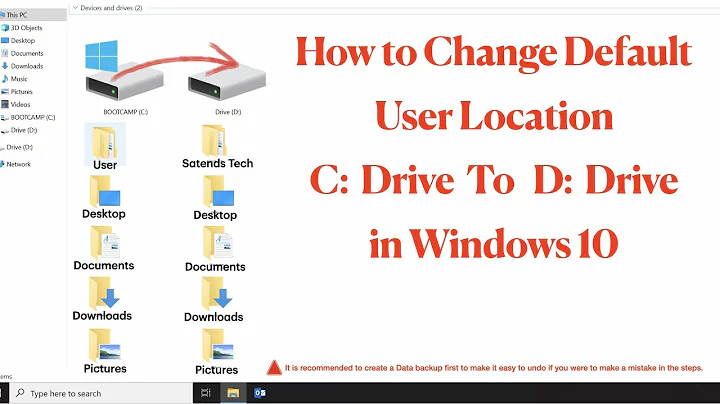What happened to the B: drive in Windows and why does the hard drive default to C?
Solution 1
Because back in the day of floppy disks, there were either two physical floppy drives (A: and B:), or just one physical floppy drive (A:) with one emulated (B:) so you could copy from disk to disk by exchanging disks every few hundred KB.
Solution 2
The A and B slots are very useful when you want to give a particular removable device the same drive letter each time it's inserted. Windows will never assign A or B to a device, but if you assign A or B to a device using Disk Manager, that drive letter will be assigned on future inserts.
I keep my source control database on a USB key so I can transfer it between multiple machines, and always assign it to B because I know that drive letter will be available on every machine. Finding this trick simplified my life greatly.
Solution 3
You can map a drive as B: if you want. Under computer management, go to storage/disk management. Right click the drive you want and choose "change drive letter/paths" You should be able to select B: as an option.
Related videos on Youtube
asok
Updated on September 17, 2022Comments
-
asok over 1 year
Why is it that I see an
A:drive and aC:drive but not aB:drive?Is there a reason why the disk partitions start at C? And is it possible to change that letter designation?
-
 Admin over 12 yearsAlso directly related - What are the Windows A: and B: drives used for?
Admin over 12 yearsAlso directly related - What are the Windows A: and B: drives used for?
-
-
ukanth over 14 yearsCan we change it ?
-
Andrew Arnott over 14 yearsThe tradition, or make C: become B:? In Windows' Disk Management console, you can in fact assign hard drives the B: drive letter. But you can't reassign the drive letter of the system drive (usually C:) because the OS would go crazy if its own drive letter changed.
-
 Admin over 14 yearsSome of us still actually have B: drives in our machines. I've got so many floppy drives laying around that I usually just go ahead and throw 2 in the boxes I put together. Surprisingly, it actually comes in handy from time to time!
Admin over 14 yearsSome of us still actually have B: drives in our machines. I've got so many floppy drives laying around that I usually just go ahead and throw 2 in the boxes I put together. Surprisingly, it actually comes in handy from time to time! -
 Admin over 14 yearsWhat do you store on floppies that is still readable nowadays?
Admin over 14 yearsWhat do you store on floppies that is still readable nowadays? -
Goyuix over 14 yearsThe GUI won't always allow you to assign A or B to volumes, but DISKPART will. Just SELECT the correct disk/volume then call ASSIGN LETTER=B and your volume will use the new letter.
-
 Admin over 14 years@Brian: i hate to break it to you, but you are an exception to the rule, and a rather rare one at that. :)
Admin over 14 years@Brian: i hate to break it to you, but you are an exception to the rule, and a rather rare one at that. :) -
David Thornley over 14 yearsWay back when, there was no such thing as an emulated floppy drive, and hard disks were expensive. Computers would normally come with two floppy drives. One of the real big complaints with the early Macintoshes was that they had only one floppy drive, and no hard drive.
-
Peter Olsson over 14 yearsalways available... unless your answer gets accepted!
-
 Admin over 14 yearsI have a (working) PDP-11 in a back room that has a working 8" floppy drive and a 9-track tape drive. I also keep a few PCs around with working stale drives and OS installs. It does come in handy.
Admin over 14 yearsI have a (working) PDP-11 in a back room that has a working 8" floppy drive and a 9-track tape drive. I also keep a few PCs around with working stale drives and OS installs. It does come in handy. -
hasen over 14 years-1, that's not why.
-
Brian Knoblauch over 14 yearsWouldn't be available if you plugged it into my machine. I have 2 floppy drives... :-)
-
 Admin over 14 yearsStill have to put drivers on floppies for OS installs sometimes (when hard drive driver required). Also use for moving small files around between machines that don't have free (or working) USB ports. Lots of little random stuff that us programmer/sysadmin people run into on a regular basis that a typical computer user may never encounter.
Admin over 14 yearsStill have to put drivers on floppies for OS installs sometimes (when hard drive driver required). Also use for moving small files around between machines that don't have free (or working) USB ports. Lots of little random stuff that us programmer/sysadmin people run into on a regular basis that a typical computer user may never encounter. -
Brian Knoblauch over 14 yearsI really don't see why people map drives at all anymore. Full network paths can be added sort of like "favorites" to your network places. Then, you can just select those instead of having to remember exactly where a particular drive letter points to. I use tons of network drives, yet only have a single mapped drive setup (to support a legacy app that can't handle UNC paths).
-
 Admin over 14 yearsbut hardly ever those 360/720 kb 5 1/2 floppies used in what was commonly known as the B; Drive. :)
Admin over 14 yearsbut hardly ever those 360/720 kb 5 1/2 floppies used in what was commonly known as the B; Drive. :) -
 Sandeepan Nath over 14 yearsException noted. :)
Sandeepan Nath over 14 yearsException noted. :) -
Michael Stum over 14 yearsBy the way: C: is traditionally the first hard drive, but it does not need to be the system drive, you can happily install Windows on F: or I:, it's just hard (if not impossible) to change the Windows Drive Letter after installation.
-
 Chris W. Rea over 14 yearsIf you're into the command-line, the drive letters are very quick to type. So, as long as your memory is good, you can save many keystrokes.
Chris W. Rea over 14 yearsIf you're into the command-line, the drive letters are very quick to type. So, as long as your memory is good, you can save many keystrokes. -
Nicolas R over 14 yearsAnd some older programs assume C: (a) exists and (b) contains Program Files.
-
Linker3000 about 13 yearsSorry, not correct. A: and B: can be any combination of BIOS-supported drives/sizes/capacities.
-
Jack B Nimble about 13 yearsAnd you can always use subst to create a virtual drive C if something truely requires it. subst c:\ E:\
-
RBerteig about 13 years@Jack, I kept a couple of network shares all set and ready to go to
net useas C:. One was for a very stale product I was stuck maintaining that required some parts of itself be located in folders right at the root of C:. It was really convenient to not actually have a C: of my own for that project. These days I would just set up a virtual PC to develop and test inside, of course. -
anil about 13 yearsof course it can, any letter can be any drive you'd like. but by default it's as i said.
-
anil about 13 yearsand yet, that's how a lot of system where setup
-
kinokijuf over 12 yearsI keep my Zip drive on B: (yes, I have a Zip drive ;-)
-
kinokijuf over 12 years@Macha Not older. Badly written.
-
kinokijuf over 9 years@TankorSmash Windows has always allowed installing to drives other than
C:. If you start install from an existing operating system, the drive mappings get preserved.




